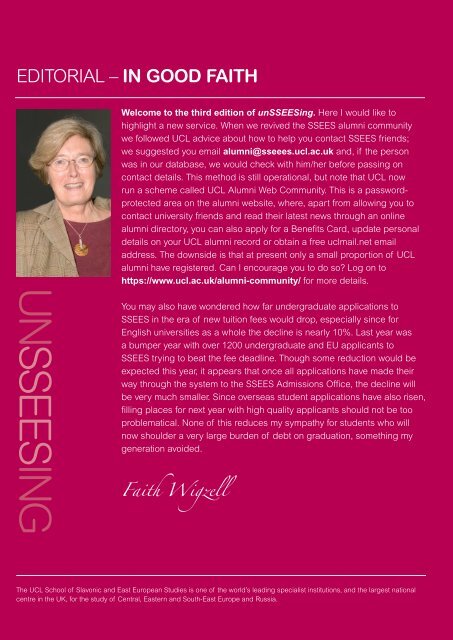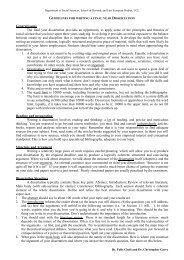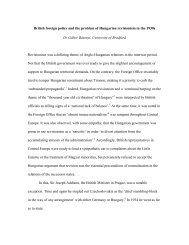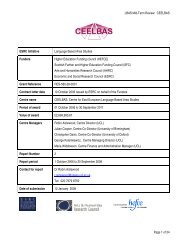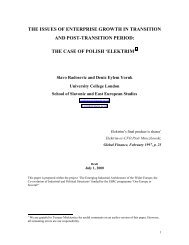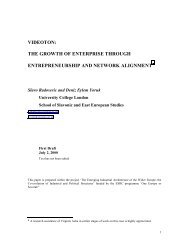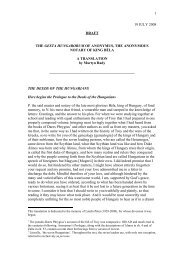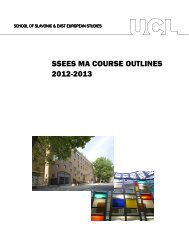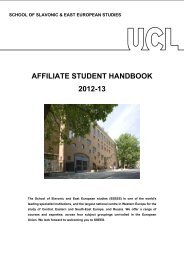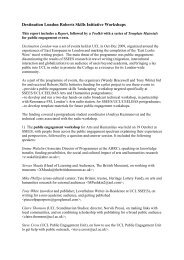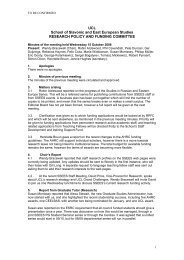UNSSEESING THE ALUMNI MAGAZINE FROM SSEES ...
UNSSEESING THE ALUMNI MAGAZINE FROM SSEES ...
UNSSEESING THE ALUMNI MAGAZINE FROM SSEES ...
Create successful ePaper yourself
Turn your PDF publications into a flip-book with our unique Google optimized e-Paper software.
UCL <strong>SSEES</strong> Alumni Newsletter 2 UCL <strong>SSEES</strong> Alumni Newsletter 3<br />
EDITORIAL – IN GOOD FAITH<br />
<strong>UN<strong>SSEES</strong>ING</strong><br />
Welcome to the third edition of un<strong>SSEES</strong>ing. Here I would like to<br />
highlight a new service. When we revived the <strong>SSEES</strong> alumni community<br />
we followed UCL advice about how to help you contact <strong>SSEES</strong> friends;<br />
we suggested you email alumni@sseees.ucl.ac.uk and, if the person<br />
was in our database, we would check with him/her before passing on<br />
contact details. This method is still operational, but note that UCL now<br />
run a scheme called UCL Alumni Web Community. This is a passwordprotected<br />
area on the alumni website, where, apart from allowing you to<br />
contact university friends and read their latest news through an online<br />
alumni directory, you can also apply for a Benefits Card, update personal<br />
details on your UCL alumni record or obtain a free uclmail.net email<br />
address. The downside is that at present only a small proportion of UCL<br />
alumni have registered. Can I encourage you to do so? Log on to<br />
https://www.ucl.ac.uk/alumni-community/ for more details.<br />
You may also have wondered how far undergraduate applications to<br />
<strong>SSEES</strong> in the era of new tuition fees would drop, especially since for<br />
English universities as a whole the decline is nearly 10%. Last year was<br />
a bumper year with over 1200 undergraduate and EU applicants to<br />
<strong>SSEES</strong> trying to beat the fee deadline. Though some reduction would be<br />
expected this year, it appears that once all applications have made their<br />
way through the system to the <strong>SSEES</strong> Admissions Office, the decline will<br />
be very much smaller. Since overseas student applications have also risen,<br />
filling places for next year with high quality applicants should not be too<br />
problematical. None of this reduces my sympathy for students who will<br />
now shoulder a very large burden of debt on graduation, something my<br />
generation avoided.<br />
Faith Wigzell<br />
The UCL School of Slavonic and East European Studies is one of the world’s leading specialist institutions, and the largest national<br />
centre in the UK, for the study of Central, Eastern and South-East Europe and Russia.<br />
MAPPING ST PETERSBURG<br />
The city of St Petersburg with its canals, elegant ironwork bridges, dark winters and white summer<br />
nights looms large in Russian literature. Shaking off the literary associations when you visit the city<br />
is well nigh impossible.<br />
Image<br />
Monument to Dostoevsky<br />
on Raskolnikov’s House,<br />
Stoliarnyi pereulok<br />
Dr Sarah Young has initiated a fascinating<br />
new digital project, Mapping St Petersburg:<br />
Experiments in Literary Cartography<br />
(www.mappingpetersburg.org). She writes:<br />
‘I have long been interested in the city’s role<br />
not simply as a setting for some of the greatest<br />
works of Russian literature, but also as the<br />
place that spurred the development of Russian<br />
literary culture. Thinking about the ways the<br />
geography of the city shaped its literature,<br />
and conversely, how the Petersburg works of<br />
Pushkin, Gogol, Dostoevsky and others have<br />
altered our understanding of the cityscape, led<br />
me to consider the potential of visualizing the<br />
spatial dynamics of literature.<br />
Mapping a text involves addressing various<br />
dimensions of its relationship to the city:<br />
the difference between static locations and<br />
movement through space, and between<br />
places and events. I began with Crime and<br />
Punishment – an exceptionally detailed novel<br />
in its references to Petersburg locations. The<br />
result is a set of annotated maps that reveal<br />
the changing use of space in different parts<br />
of the novel, and unexpected topographical<br />
connections between characters – intriguing<br />
findings that point towards new interpretations.<br />
With the help of John Levin (www.anterotesis.<br />
com), who makes the maps and provides<br />
technical support, we have now added maps<br />
of Gogol’s Petersburg Tales, showing the<br />
centrality of Nevsky Prospect in his fictional<br />
world, and an opposition between places<br />
that actually appear in the stories and spaces<br />
simply referred to. The project will eventually<br />
incorporate other literary texts, visual art and<br />
historical data.’<br />
If you have a love of classic Russian<br />
literature or St Petersburg, please do take<br />
a look at the website. Comments and<br />
suggestions are particularly welcome.


